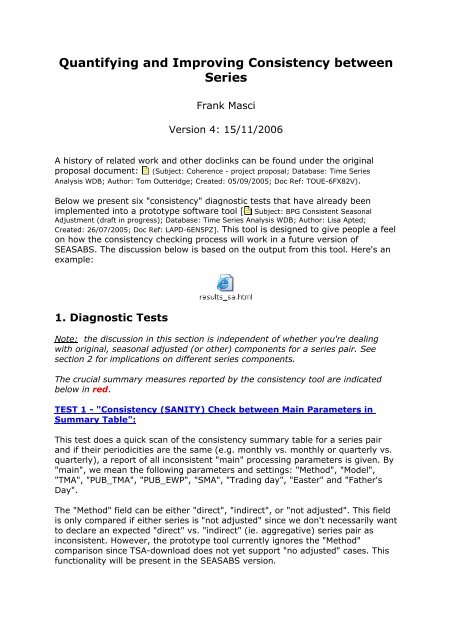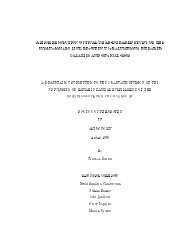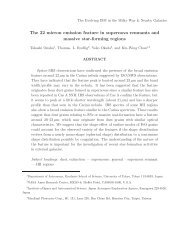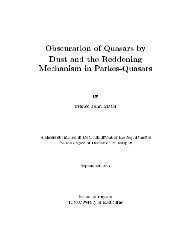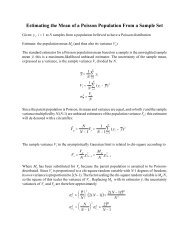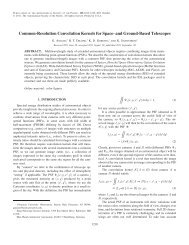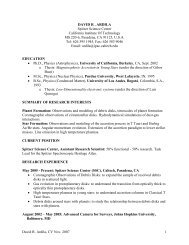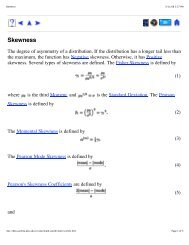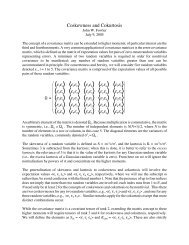Quantifying Consistency Version 3 (PDF)
Quantifying Consistency Version 3 (PDF)
Quantifying Consistency Version 3 (PDF)
Create successful ePaper yourself
Turn your PDF publications into a flip-book with our unique Google optimized e-Paper software.
<strong>Quantifying</strong> and Improving <strong>Consistency</strong> between<br />
Series<br />
Frank Masci<br />
<strong>Version</strong> 4: 15/11/2006<br />
A history of related work and other doclinks can be found under the original<br />
proposal document: (Subject: Coherence - project proposal; Database: Time Series<br />
Analysis WDB; Author: Tom Outteridge; Created: 05/09/2005; Doc Ref: TOUE-6FX82V).<br />
Below we present six "consistency" diagnostic tests that have already been<br />
implemented into a prototype software tool [ Subject: BPG Consistent Seasonal<br />
Adjustment (draft in progress); Database: Time Series Analysis WDB; Author: Lisa Apted;<br />
Created: 26/07/2005; Doc Ref: LAPD-6EN5PZ]. This tool is designed to give people a feel<br />
on how the consistency checking process will work in a future version of<br />
SEASABS. The discussion below is based on the output from this tool. Here's an<br />
example:<br />
1. Diagnostic Tests<br />
Note: the discussion in this section is independent of whether you're dealing<br />
with original, seasonal adjusted (or other) components for a series pair. See<br />
section 2 for implications on different series components.<br />
The crucial summary measures reported by the consistency tool are indicated<br />
below in red.<br />
TEST 1 - "<strong>Consistency</strong> (SANITY) Check between Main Parameters in<br />
Summary Table":<br />
This test does a quick scan of the consistency summary table for a series pair<br />
and if their periodicities are the same (e.g. monthly vs. monthly or quarterly vs.<br />
quarterly), a report of all inconsistent "main" processing parameters is given. By<br />
"main", we mean the following parameters and settings: "Method", "Model",<br />
"TMA", "PUB_TMA", "PUB_EWP", "SMA", "Trading day", "Easter" and "Father's<br />
Day".<br />
The "Method" field can be either "direct", "indirect", or "not adjusted". This field<br />
is only compared if either series is "not adjusted" since we don't necessarily want<br />
to declare an expected "direct" vs. "indirect" (ie. aggregative) series pair as<br />
inconsistent. However, the prototype tool currently ignores the "Method"<br />
comparison since TSA-download does not yet support "no adjusted" cases. This<br />
functionality will be present in the SEASABS version.
Note that trend breaks, seasonal breaks, large extremes and additive outliers are<br />
excluded from this test since these are covered under a more general framework<br />
in the "movement" tests below. If the periodicities of a pair are different (e.g.<br />
monthly vs. quarterly), then differences in the above "main" parameters are<br />
allowed (or expected). But please check that they do indeed make sense for<br />
each series.<br />
A summary of this test is prefixed by lines with "***" in the consistency tool:<br />
E.g. you should review the parameters and/or settings if you see something like:<br />
*** The "X11 TMA, PUB_TMA, " parameter settings are not<br />
consistent for this series pair. Please review.<br />
Otherwise, you'll be satisfied (with regards to these "main" parameters/settings<br />
only!) if you see:<br />
*** All main processing parameters for this series pair are consistent (i.e.<br />
"Model", "TMA", "PUB_TMA", "PUB_EWP", "SMA", "Trading day", "Easter" and<br />
"Father's Day").<br />
If the periodicities of each series in the pair are different, then you'll see:<br />
*** Periodicities are not the same: inconsistencies are expected in processing<br />
parameters and settings. Please check all are appropriate.<br />
TEST 2 - "Cross-Correlation for Relatedness":<br />
This presents a simple sanity check to ensure that the series pair are related.<br />
This can be classified as a "weak" consistency measure since if an input series<br />
pair are declared to be "conceptually" related on apriori grounds (which is the<br />
working hypothesis), then it is guaranteed that their movements are correlated<br />
to some degree. But it doesn't hurt to check.<br />
!<br />
The basis of this test is to ensure that the cross-correlation coefficient<br />
between movements is significantly different from zero at some lag h. i.e. we<br />
test:<br />
H : ρ( M , M ) = 0 versus H : ρ( M , M ) ≠0<br />
0 1 2 h<br />
1 1 2 h<br />
!<br />
Rejection of this null hypothesis (at some significance level) at any of the<br />
interesting lags: h=-3 -> 3 implies that the movements are "related" in some<br />
way (note that correlated does not imply equal). In most "conceptually<br />
related" series cases, we expect to see a positive significant peak in ρ at lag<br />
zero (=CCF(0); i.e. no shift between the series).
!<br />
!<br />
In the consistency tool output, we quote these measures with and without<br />
outlying movements included. These outliers are identified using robust linear<br />
regression as described in TEST 4 below. The presence of outliers in the joint<br />
movement distribution may skew estimates of ρ (i.e. reduce their<br />
significance), leading one to reject an otherwise significant underlying<br />
correlation (or relatedness). We therefore present estimates with and without<br />
inclusion of outliers. The latter gives us a second chance at assessing<br />
relatedness. For your convenience, we provide plots of CCF versus h for each<br />
of these cases.<br />
Along with the CCF(0) measures, we also quote 95% confidence intervals<br />
expected for the population ρ (from Fisher's z-transformation method). If<br />
these intervals include the value zero, then H 0<br />
is accepted at some P-value<br />
>5% and no amount of processing can make it better. A concise summary of<br />
this test is prefixed by "***" in the consistency tool output summary:<br />
E.g. you should be concerned if you see something like:<br />
"*** CROSS-CORRELATION COEFFICIENT (WITHOUT OUTLIERS)<br />
CONSISTENT WITH ZERO AT >5% LEVEL => SERIES MAY NOT BE RELATED"<br />
Otherwise, all is well (at the
Our goal here is to determine whether a significant global difference in<br />
movements is either wholly due to a global relative offset (e.g. non-zero<br />
intercept β), a scale factor (e.g. non-unit slope α) or both. In other words,<br />
if<br />
M<br />
M<br />
−M<br />
2 1<br />
−M<br />
2 1<br />
≠0 then either:<br />
≈β<br />
OR<br />
2<br />
2<br />
−<br />
1<br />
≈( α −1)<br />
1<br />
⇔ ≈<br />
M1<br />
M M M<br />
M −M ≈( α − 1) M + β.<br />
2 1 1<br />
M<br />
α<br />
OR<br />
If you're feeling ambitious, you may want to show that the variance in the<br />
difference of the movements can be written:<br />
σ<br />
2<br />
( M1−M2)<br />
⎛σ<br />
2 2<br />
⎧ σM1+ σM2 −2ρσM1σM2<br />
ρ ≤1,<br />
⎪<br />
2 2<br />
⎪σM1(1− 2 α) + σM2; α
Movement Series 2<br />
{β > 0; α=1}<br />
{β = 0; α < 1}<br />
β<br />
Movement Series1<br />
{β > 0; α=1}<br />
β<br />
{β = 0; α < 1}<br />
M 1 -M 2 distribution<br />
Figure 1: interpretation of non-zero intercept / non-unit slope.<br />
!<br />
!<br />
A significantly non-zero intercept will have a different interpretation from a<br />
significantly non-unit slope. Either or both of these imply an inconsistency in<br />
movement magnitudes in the broad sense and the above test is an attempt<br />
to probe the relationship of the movement magnitudes further. Whether the<br />
movement magnitudes from two series are related in a multiplicative or<br />
additive way will be of great interest to the client.<br />
The consistency tool output includes a plot of the movements in series 1<br />
versus that in series 2 at equal times. E.g:
Figure 2: example movement versus movement plot from<br />
consistency tool.<br />
The black solid line defines the "line of equal movements", the blue dashed line<br />
is the robust linear regression fit, the green lines encompass a ~99.73% (~3σ)<br />
confidence interval for the residuals about this fit and the crosses indicate<br />
outliers falling outside this interval. See TEST 4 for their detection method.<br />
Obviously the more the blue dashed line coincides with the black line, the more<br />
"consistent" are the movement magnitudes.<br />
! The consistency tool outputs diagnostics of the linear regression and a<br />
concise summary of this test is given by lines prefixed by "***":<br />
E.g. you should make a note and let the client know if you see something<br />
like:<br />
*** MEAN DIFFERENCE IN MOVEMENTS SIGNIFICANTLY DIFFERENT FROM<br />
ZERO AT 5% LEVEL<br />
which could be due to either of following:<br />
*** FITTED SLOPE SIGNIFICANTLY DIFFERENT FROM ONE AT 5% LEVEL<br />
*** FITTED INTERCEPT SIGNIFICANTLY DIFFERENT FROM ZERO AT 5%<br />
LEVEL<br />
Otherwise, all is well if you see (for example with p-values >5%):<br />
*** MEAN DIFFERENCE IN MOVEMENTS CONSISTENT WITH ZERO AT 36.97<br />
% LEVEL<br />
*** FITTED SLOPE CONSISTENT WITH ONE AT 16.45 % LEVEL<br />
*** FITTED INTERCEPT CONSISTENT WITH ZERO AT 65.23 % LEVEL
TEST 4 - "Movement versus Movement Outlier Test":<br />
This test is probably the most useful of all. The basis of this test is the detection<br />
of outliers in the movement versus movement plot (e.g. see Figure 2 above).<br />
Depending on the series component under investigation, the presence of<br />
discrepant movements reveal inconsistencies at the same time points between<br />
two series. For example, if "prior-corrected" (D11) seasonally adjusted series are<br />
being compared, then the presence of a large movement in one series but not<br />
the other may imply that there has been an inconsistent prior-correction applied,<br />
or, that the actual originals are conceptually different at those timepoints.<br />
!<br />
Outlier movements are detected by identifying those residuals r i<br />
about a<br />
"robust" linear regression fit that exceed some thresold "t " of the Median<br />
Absolute Deviation (MAD measure) from the median. i.e. an outlier is declared<br />
if:<br />
{ }<br />
ri<br />
− median ri<br />
> t, where<br />
MAD<br />
MAD = 1.4826 * median r −med r<br />
{ i { i}<br />
}<br />
The numerical prefactor is a correction for asymptotic normality so that MAD<br />
~ σ for large N . In this limit, the threshold "t " can therefore be expressed in<br />
terms of the number of standard deviations (e.g. 2σ , 3σ etc..; the consistency<br />
tool has this hardcoded at 3σ). The green bands in Figure 2 above represent: α*<br />
M1 + β +/- 3σ (with α and β from TEST 3). We use the "MAD" measure because<br />
of its robustness.<br />
!<br />
A list of all outliers detected are reported in the diagnostics output. It is<br />
recommended that the user trace their cause. An example output is as<br />
follows:<br />
*** NUMBER OF > 3 SIGMA OUTLIERS DETECTED IN MOVEMENT VS MOVEMENT<br />
PLOT = 6 :<br />
* ALL OUTLIERS:<br />
* MNTH or QTR/YEAR | MVT1(%) | MVT2(%) | approx.#SIGMA | P-VALUE:<br />
* ------------------------------------------------------------------------------<br />
* 3/1977 | -9.61 | 7.78 | 10.12 | 4.307e-024<br />
* 4/1977 | 15.35 | 3.97 | -6.32 | 2.539e-010<br />
* 3/1978 | 4.09 | 13.46 | 5.65 | 1.609e-008<br />
* 3/1979 | 18.47 | 30.30 | 7.35 | 2.039e-013<br />
* 1/1981 | 11.02 | 4.08 | -3.79 | 1.486e-004<br />
* 3/1981 |-11.28 | -5.64 | 3.20 | 1.357e-003<br />
* ------------------------------------------------------------------------------<br />
TEST 5 - "Test for Significant Temporal Pattern in Movement<br />
Differences":<br />
We attempt to search for a regular pattern in "excess" (or outlying) movement<br />
difference (M1 - M2) as a function of time. By excess, we mean values of the
movement differences that exceed some threshold (see below). For instance, if a<br />
significant pattern is found between seasonally adjusted components on<br />
timescales of 12 months, then this may imply that residual seasonality is present<br />
in one series but not the other. Note that this test is not sensitive at detecting<br />
residual seasonal movements of the same magnitude in both series. If we are<br />
examining original (unmodified) series, then a significant pattern in thresholded<br />
"M1 - M2" values may imply different seasonal patterns.<br />
!<br />
!<br />
The first step involves finding all movement differences D i<br />
= M1 i<br />
- M2 i<br />
that<br />
exceed some thresold "t " of the Median Absolute Deviation (MAD measure)<br />
from the median. In other words, the detection of excess movement<br />
differences uses the same algorithm as used for detecting residual outliers in<br />
TEST 4 with r i<br />
replaced by D i<br />
.<br />
If an excess is detected, we assign an indicator variable i(t) with the value 1,<br />
or 0 if the movement difference falls below the threshold. In the consistency<br />
tool, this threshold is hardcoded at 2σ. In algorithmic terms,<br />
{ it () = 1 }<br />
{ it () = 0 }<br />
{ }<br />
⎛ Di<br />
− median D ⎞<br />
i<br />
if > t , where MAD = 1.4826 * median{ Di<br />
−med { Di}<br />
},<br />
⎜ MAD ⎟<br />
⎝<br />
⎠<br />
else<br />
!<br />
Given the time sequence of indicator variables, i(t) , we then explore whether<br />
it exhibits a significant pattern by computing its autocorrelation and<br />
partial-autocorrelation functions (ACF[ i(t) ] and PACF[ i(t) ] respectively) at<br />
a number of interesting time lags h = 1...12. Our null and alternative<br />
hypotheses are:<br />
H : ACF[ i( t)] = 0 versus H : ACF[ i( t)] ≠ 0 and<br />
0 lag h<br />
1<br />
H : PACF[ i( t)] = 0 versus H : PACF[ i( t)] ≠0<br />
0 lag h<br />
1<br />
lag h<br />
lag h<br />
!<br />
!<br />
Rejection of H 0<br />
for both the ACF and PACF at any lag implies a significant<br />
temporal pattern in thresholded movement differences (M1 - M2) at that time<br />
lag. On the other hand, acceptance of H 0<br />
at all lags implies no temporal<br />
patterns are present. The reason why we consider both the ACF and PACF is<br />
because the ACF values on their own do not measure the "true"<br />
autocorrelation at a specific lag. A significant ACF value at say lag 12 could be<br />
due to the indirect propagation of autocorrelation signal at smaller lags. The<br />
PACF values have the effects from intervening lags removed. A joint<br />
comparison of the ACF and PACF values makes this test more robust.<br />
The consistency tool produces as output, plots of the indicator variable i(t)<br />
and the ACF and PACF of i(t) at lags h=1 to 12 lags. The ACF and PACF plots<br />
show the 95% confidence intervals ( ~ +/-1.96/sqrt[ N ] ) outside which<br />
values can be considered significant. There is also a summary of this test. If a
significant temporal pattern is found, you'll see, for example:<br />
* MOVEMENT DIFFERENCE THRESHOLD = 2 SIGMA<br />
* NUMBER OF |M1 - M2| VALUES ABOVE THRESHOLD = 5<br />
* LAGS WHERE ACF & PACF[i(t)] ARE GREATER THAN 95% CL VALUE: LAG 4<br />
;<br />
* => REJECT "H0: ACF & PACF[i(t)]=0" OF NO PATTERN IN MOVEMENT<br />
DIFFERENCES<br />
* => SYSTEMATIC INCONSISTENCY EXISTS AT ABOVE (LAG) PERIODICITIES<br />
(CHECK ACF PLOTS)<br />
It's important to never believe these conclusions outright. As the last line<br />
implies: "CHECK ACF PLOTS". You want to ensure that there is indeed a<br />
systematic pattern in the indicator { i(t) } sequence. The plots corresponding to<br />
this example are below. As you see, the reported significant autocorrelation at<br />
lag 4 only occurs over a three year span. Since this is a quarterly series, it<br />
implies an excess seasonal movement difference at these consecutive three<br />
years between the two series. This warrants a look at the actual S*I charts for<br />
these series.
TEST 6 - "Unit Root & Cointegration Tests":<br />
Goals and Motivation:<br />
The above diagnostic tests exclusively focused on the movements<br />
(first-differences) in each series of a conceptually related pair. The reason for<br />
this is that first differences are likely to be 'stationary' for most<br />
economic/business-like series. If one attempts to correlate levels directly, then<br />
correlation measures may be spurious due to the presence of non-stationarity (a<br />
feature of most economic series since they usually show an upwards trend).<br />
Correlation measures will be biased towards explaining global long-term<br />
relationships in the trend levels since both depend (usually linearly) on a third<br />
variable - "time". The correlation measures derived therefrom will not be a true<br />
representation of relationships on the short timescales sought for (i.e. on which<br />
the series are sampled).<br />
To see this via an example, consider two non-stationary series X t<br />
and Y t<br />
, say with<br />
deterministic trends of unequal slopes c 1<br />
, c 2<br />
:<br />
X t<br />
= c 1<br />
.t + e t<br />
Y t<br />
= c 2<br />
.t + e' t<br />
,<br />
where e t<br />
and e' t<br />
are zero mean IID noise sequences.<br />
The covariance between these series can be written:<br />
cov[X t<br />
, Y t<br />
] = <br />
= c 1<br />
.c 2<br />
.var(t)<br />
which is clearly non-zero and depends on the variance of the timepoints in the<br />
span. This means that the correlation is due to the relationship in the overall<br />
trends, not between underlying point-to-point movements across series where<br />
correlations are expected to be zero (i.e. cov[e t<br />
.e' t<br />
] = 0).<br />
Furthermore, consider a linear regression between these two series: X t<br />
and Y t<br />
:<br />
Y t<br />
= B.X t<br />
+ A ,<br />
where A and B are parameters of the regression. The residuals from this<br />
regression:<br />
u t<br />
= Y t<br />
- B.X t<br />
- A<br />
= (c 2<br />
- B.c 1<br />
).t + e' t<br />
- B.e t<br />
- A<br />
will be non-stationary and highly autocorrelated at all lags. Consequently<br />
correlation measures and t-statistics on parameter estimates will be biased<br />
(former overestimated and latter underestimated) since there are 'unexplained'
non-white noise residuals in the regression. Cointegration tests can help alleviate<br />
and/or assess cases that may lead to spurious correlations.<br />
Cointegration is provided here for informational purposes and explores whether<br />
there exists a stable 'long-run' (ie. equilibrium) relationship between two series,<br />
or put another way, whether they have common long-term stochastic trends. If<br />
so, the series are 'cointegrated'. If a pair of series are cointegrated, then one of<br />
them may 'cause' the other. Since the series pairs fed into the consistency tool<br />
are expected (or known a-priori) to be conceptually related, cointegration should<br />
follow naturally. Below we provide a brief overview of the tests performed. For a<br />
more in depth discussion with links to lecture notes, see (Subject: Cointegration<br />
notes/articles..; Database: Time Series Analysis WDB; Author: Frank Masci; Created: 14/06/2006;<br />
Doc Ref: FMAI-6QR3PB).<br />
Unit Root Tests:<br />
!<br />
Before testing for cointegration, we must first determine if both series are<br />
consistent with "integrated" processes of the same order. By "integrated", we<br />
mean they have underlying 'non-stationary' stochastic trends (just like a<br />
classic random walk), as opposed to deterministic trends which can also be<br />
non-stationary. An 'integrated' process results from a cumulative sum of<br />
repeated stochastic disturbances over time. Consider the following process<br />
and it's first difference:<br />
y = ρ y + e<br />
t t−1<br />
t<br />
∆ y = δ y + e,<br />
t t−1<br />
t<br />
where δ = ρ−1 and ∆ y = y − y .<br />
t t t−1<br />
The classic random walk is defined by ρ = 1 and its first difference has δ = 0.<br />
This model is said to have a "unit root" and is non-stationary. If a series with an<br />
underlying stochastic trend has to be differenced once in order to make it<br />
stationary, then it is called "integrated of order one", or I(1). A series which<br />
needs to be differenced d times before it is stationary is called I(d). We limit<br />
ourselves to testing for I(1) cases only since these underly most economic-like<br />
series. We perform two separate unit-root tests on each series to determine if<br />
each is I(1):<br />
!<br />
The first unit root test is the Augmented Dickey-Fuller (ADF) test (e.g.<br />
"ur.df" function in the "urca" R package). This is based on performing the<br />
following general regression:<br />
∆ y = β + β t+ δy + α ∆ y + e , (1)<br />
t 1 2 t−1<br />
i t−i t<br />
i=<br />
1<br />
m<br />
∑<br />
i.e. 'nested' constant and trend terms are included and if the error term e t<br />
is<br />
autocorrelated, lagged difference terms are added to soak up any residual<br />
autocorrelations so to ensure whiteness in e t<br />
. m is the number of lagged<br />
difference terms to include (m = 0 corresponds to a straight 'Dickey-Fuller' test).<br />
The ADF test is based on testing the null and alternative hypotheses:
H<br />
0<br />
1<br />
: δ = 0 ⇒ y contains a unit root and is integrated with order one = "I(1)"<br />
versus<br />
t<br />
H : − 2 < δ < 0 ⇒ y stationary "stochastic" process (not integreated)<br />
t<br />
!<br />
!<br />
!<br />
!<br />
The second unit root test performed is called the Phillips-Perron Test (e.g.<br />
"ur.pp" function in the "urca" R package). This is a variant of the ADF test in<br />
that different estimators and statistics for the null distribution in δ and<br />
coefficients for lagged differences (α i<br />
) are used, mostly based on<br />
semi-parametric methods. The method includes a more careful consideration<br />
of possible correlations between all parameter estimates (slope and intercept<br />
terms included). This test is known to be more powerful than the ADF test<br />
when structural breaks (or sudden impacts) are present in a series. Breaks<br />
can render a series non-stationary (integrated) when it is really stationary<br />
(i.e. type II error). Like the ADF test, this test also has 'poor' finite sample<br />
behaviour (say for spans N
! The first is called the "Augmented Engle-Granger (AEG) test". This is<br />
based on first performing a linear regression between two series: X t<br />
and Y t<br />
:<br />
Y t<br />
= b.X t<br />
+ a ,<br />
where a and b are parameters. This is rearranged to obtain the actual<br />
regression residuals:<br />
u t<br />
= Y t<br />
- b.X t<br />
- a.<br />
Now the series u t<br />
can be seen as a linear combination of series X t<br />
and Y t<br />
and if<br />
it is stationary, then effectively the trends in X t<br />
and Y t<br />
(stochastic or otherwise)<br />
'cancel out'. In this case, X t<br />
and Y t<br />
are cointegrated with cointegrating parameter "<br />
b ". Note that if the series are described by multiplicative decomposition models,<br />
then logs of the series are regressed instead. This is to ensure stationarity in the<br />
variance of regression residuals. However, this is not a strict requirement for the<br />
AEG test since it is based entirely on testing for stationarity in the mean of the<br />
residuals.<br />
!<br />
!<br />
!<br />
!<br />
The basis of this test is to first ensure that two series are integrated with the<br />
same, non-zero order, i.e. both have underlying stochastic (non-constant)<br />
trends. If not, then there's no point in going on since u t<br />
will be expected to be<br />
either non-stationary (the series don't track each other), or, if both input<br />
series are I(0) (already stationary), then there will be no 'common' long-term<br />
trends to correlate. In other words we cannot infer any long-run equilibrium<br />
relationship between two series if they are made (or are already) stationary.<br />
This is the basis of cointegration.<br />
Note that a linear combination between two I(0) processes can still be<br />
stationary if they exhibit similar underlying autocorrelation structures. We can<br />
therefore still attempt to perform a regression between two series if both are<br />
I(0). Correlation measures derived therefrom are not expected to be<br />
spurious. However, as discussed, we cannot proceed with cointegration tests<br />
since the relationship (if any) is only local (i.e. in the short run).<br />
Cointegration aims to explore long-run steady-state causal relationships<br />
between integrated (non-stationary) processes.<br />
Therefore, given the requirement of equal non-zero integration order, two<br />
time series are cointegrated if the residual term from a regression of one on<br />
the other is stationary in the long run. Note that two independent random<br />
walks are both I(1) but they are very unlikely to be cointegrated since the<br />
chance that they will track each other in the long run (hence giving stationary<br />
regression residuals) is miniscule.<br />
The AEG test is based on applying ADF test described above to the residuals<br />
series u t<br />
with maximum lag order m = 2. The null and alternative hypothesis<br />
are:<br />
H<br />
0<br />
1<br />
: δ = 0 ⇒u<br />
non-stationary ⇒ series pair non-cointegrating<br />
versus<br />
t<br />
H : − 2 < δ < 0 ⇒u<br />
stationary ⇒ series pair is cointegrating<br />
t<br />
The usual critical values for the ADF statistic as used for the unit-root test
above are not appropriate here due to the combination and interplay of two<br />
integrated processes. Instead we use the critical τ statistics for Engle-Granger<br />
cointegration as derived by MacKinnon, J. G., 1996. These critical values also<br />
contain finite sample corrections (ie. depend on the number of observations) so<br />
that large-sample requirements (as assumed in the univariate ADF tests) can be<br />
relaxed.<br />
Cointegration Test 2:<br />
The second test is considered more general in the econometrics world. This is<br />
"Johansen's Vector Auto-Regressive, Error Correction Model" (VAR-ECM)<br />
procedure. We use this method only to determine if a series pair is cointegrated<br />
and not to assess or correct deviations from long-run equilibrium.<br />
!<br />
Given two series X t<br />
and Y t<br />
integrated with the same non-zero order, this test is<br />
based on expressing the first differences (movements) in a VAR-ECM<br />
framework. The existence of a 'unique' error-correction model (ECM)<br />
representation will ensure that the series are cointegrated. In a nutshell, the<br />
VAR-ECM for two series can be written:<br />
m<br />
⎛∆Xt⎞ ⎛c1 ⎞ ⎛d1 ⎞ ⎛k11 k12<br />
⎞⎛Xt−1⎞ ⎛∆Xt−i⎞ ⎛e1t<br />
⎞<br />
⎜ ⎟= ⎜ ⎟+ ⎜ ⎟t+ ⎜ ⎟⎜ ⎟+ ∑ Mi<br />
⎜ ⎟+<br />
⎜ ⎟, (2)<br />
⎝∆Yt ⎠ ⎝c2 ⎠ ⎝d2 ⎠ ⎝k21 k22<br />
⎠⎝Yt−1 ⎠ i=<br />
1 ⎝∆Yt−i ⎠ ⎝e2t⎠<br />
where from left to right we have the vectors and matrices: first differences in<br />
the series, column vectors of constant intercept and linear (deterministic) trend<br />
coefficients, a 2x2 coefficient (or cointegrating) matrix multiplying the lagged<br />
series, a sum of lagged differences with coefficient matrix M i<br />
and maximum lag<br />
order m , and a vector of (possibly correlated) white noise components e t<br />
.<br />
!<br />
Let's consider the 'cointegrating matrix' in the above representation, i.e:<br />
⎛k11 k12<br />
⎞<br />
Π= ⎜ ⎟<br />
⎝k21 k22<br />
⎠<br />
The test for cointegration between X t<br />
and Y t<br />
is based on looking at the rank of<br />
the Π matrix. The rank of a matrix, r , is equal to the number of its non-zero<br />
eigenvalues, or equivalently, the number of linearly independent rows or<br />
columns. In this context, r is therefore equal to the number of independent<br />
cointegrating relations that exist amongst X t<br />
and Y t<br />
. For example, if Π had<br />
precisely the form:<br />
⎛α1 αβ<br />
1 ⎞<br />
Π= ⎜ ⎟ ,<br />
⎝α2 αβ<br />
2 ⎠<br />
then rank(Π) = 1 since the second row is "α 2<br />
/ α 1<br />
" times the first row and<br />
therefore there is only one linearly independent vector involved. In this case,<br />
eqn (2) can be written (omitting constant and lag terms):<br />
∆ X<br />
t<br />
= α1Xt− 1+ α1βYt− 1+ e1 t<br />
≡ α1( Xt− 1+ βYt−<br />
1)<br />
+ e1<br />
t<br />
∆ Y = α X + α βY + e ≡ α X + βY + e<br />
( )<br />
t 2 t−1 2 t−1 2t 2 t−1 t−1 1 t,
so that the 'unique' cointegrating relation is " X t-1<br />
+ βY t-1<br />
" with cointegrating<br />
vector: (1 β). Hence the linear combination:<br />
⎧ 1<br />
( ∆X<br />
t<br />
−e1<br />
t)<br />
⎪α1<br />
Xt−<br />
1+ βYt−<br />
1<br />
=⎨<br />
⎪ 1<br />
( ∆Yt<br />
−e2t)<br />
⎪⎩ α2<br />
is stationary since the ∆X t<br />
and ∆Y t<br />
and e t<br />
are stationary themselves. Each row of Π<br />
therefore represents the same cointegrating vector. We can now make the<br />
analogy with test 1 above where stationarity in the regression residuals was the<br />
criterion for cointegration.<br />
!<br />
Note that if the rank of Π were equal to its dimension, 2, then it's<br />
determinant will be non-zero and Π -1 exists. Pre-multiplying the VAR-ECM<br />
(eqn 2) with Π -1 gives (omitting constant and lag terms):<br />
'<br />
X<br />
1 t<br />
X<br />
− ⎛∆ ⎞ ⎛ t−1<br />
⎞ ⎛e<br />
⎞<br />
1t<br />
Π ⎜ ⎟= ⎜ ⎟+⎜ .<br />
' ⎟<br />
⎝∆Yt ⎠ ⎝Yt−<br />
1 ⎠ ⎝e2t<br />
⎠<br />
Since the left hand side is stationary, all terms on the right must also be<br />
stationary. This implies there cannot be a cointegrating relationship between X t<br />
and Y t<br />
since both must already be stationary. As discussed above, two stationary<br />
series can never be cointegrated (i.e. exhibit a long run dependence).<br />
!<br />
!<br />
In practice, elements of the cointegrating matrix Π are estimated by fitting<br />
eqn (2) to 'stochastic' time series data and therefore, the rank of Π needs to<br />
be estimated by testing for its number of significantly non-zero eigenvalues.<br />
This is known as Johansen's (1988) procedure and essentially involves testing<br />
for a null hypothesis of r =1 cointegrating vectors [where r = rank(Π)] against<br />
the alternative of r = 2. For more information on the specific tests, please see<br />
articles in (Subject: Cointegration notes/articles..; Database: Time Series Analysis WDB;<br />
Author: Frank Masci; Created: 14/06/2006; Doc Ref: FMAI-6QR3PB). To carry out this<br />
test, we use the "ca.jo" function in the "urca" R package.<br />
The two cointegration tests above are most powerful when series spans are<br />
reasonably long (say N >~ 100 observations) and if they have not been<br />
modified too much (ie. by the process of seasonal adjustment). Also, the<br />
same limitations that plague the unit-root tests above apply: presence of<br />
structural breaks/impacts, the role of the deterministic trend and specification<br />
of the maximum lag order.<br />
<strong>Consistency</strong> Tool Outputs:<br />
The following diagnostics are generated from the sequence of tests:<br />
(i). The ADF and Phillips-Perron unit root tests are performed on each series in<br />
succession. Following the output test statistics, a summary of these tests is<br />
given by red lines prefixed by "***":<br />
e.g. if either the ADF or Phillips-Perron tests indicate that both series are<br />
integrated (non-stationary), you will see:
*** According to either test, series 1 = integrated I(1) process [at >p% level]<br />
*** According to either test, series 2 = integrated I(1) process [at >p% level]<br />
(where p=5 or 10)<br />
or if both series are stationary you will see:<br />
*** According to either test, series 1 ~ I(0) process [at
plots for marginal cases.<br />
If both series were not integrated with the same non-zero order (from results of<br />
unit root tests above), then you would see:<br />
*** Series pair not cointegrating since components not integrated with same<br />
non-zero order<br />
2. Which Series Component and Why?<br />
After much testing, discussion and debate, it has been decided that three types<br />
of series components will satisfy all our needs on assessing consistency: originals<br />
("O"), standard ABS seasonally adjusted ("SA"; i.e. with priors included), and,<br />
X11 "prior-corrected" seasonally adjusted (= D11 table output labelled "pSA").<br />
These will allow us to quantify the accuracy of different assumptions and<br />
methodologies. The specific questions that can be addressed using the above<br />
tests on each of these components are as follows:<br />
Originals: {O 1<br />
, O 2<br />
}<br />
1. Are the series conceptually related? If not, the client should be notified that<br />
the series are not consistent or related on conceptual grounds. Is it worth the<br />
effort to proceed with the consistency check?<br />
2. Have any revisions in the data destroyed any prior association (relatedness)<br />
for a series pair?<br />
3. Do the raw series have different seasonal patterns, strengths? If so, this does<br />
not imply inconsistency!<br />
4. Do the raw series differ in any other systematic calendar-related effects?<br />
5. Do the raw series have different outlier, break strengths or numbers thereof?<br />
ABS Seasonally Adjusted: {SA 1<br />
, SA 2<br />
}<br />
1. Like above: are the series conceptually related ("minus" seasonality)?<br />
2. What are all the discrepant priors (outliers, breaks, calendar related effects)<br />
between the two series?<br />
3. Was seasonality adequately and consistently removed from each series?<br />
(D11) "Prior-Corrected" Seasonally Adjusted: {pSA 1<br />
, pSA 2<br />
}<br />
1. Like above: are the series conceptually related?<br />
2. Were all prior-corrections consistently and correctly applied to each series?<br />
This includes all calendar-related effects.<br />
3. Are there any remaining, discrepant priors not accounted for between the two<br />
each series?<br />
4. Was seasonality adequately and consistently removed from each series?<br />
!<br />
!<br />
It appears that the "pSA" components are the most useful and efficient to<br />
assess consistency, simply because they effectively represent our "end<br />
product" with priors and seasonality removed. Any remaining priors that<br />
are discordant between these series (outliers in the movement vs.<br />
movement plots - TEST 4) would not have been accounted for in your<br />
nominal, initial list of priors, therefore allowing for easier identification.<br />
However, "pSA" (D11) components are not yet available for downloading
using "TSA-download" from which the output data format is needed for the<br />
consistency tool. Nonetheless, you are not at a loss. It is advised that you<br />
use "ABS SA" components instead. The only difference is that the<br />
movement vs. movement plots (as in TEST 4) will contain all discordant<br />
priors between the two series, regardless if they've been corrected or not as<br />
specified in your nominal, initial list of priors. Therefore, you will just need to<br />
ensure that all the discordant priors are represented in your initial list of<br />
priors.<br />
!<br />
For your information, diagnostic test results will be generated for all of the<br />
above three series components in the final SEASABS version.<br />
3. Recipe: what constitutes a "Pass" or "Fail" and how<br />
do I "fix" a "Failure"?<br />
!<br />
!<br />
!<br />
!<br />
Disclaimer: our goal is to achieve the best possible consistency between a<br />
pair of "prior-corrected" (D11) seasonally adjusted series by accounting for all<br />
priors and systematic differences as best we can. This is to be achieved at a<br />
level where any residual differences are purely stochastic in nature.<br />
The main output test diagnostics were outlined in red in section 1 above. For<br />
concise reporting purposes (to be implemented in a future SEASABS), we<br />
would like to assign a "PASS" (P) or "FAIL" (F) flag to each test. Note that all<br />
tests above don't treat the word "FAIL" in the same context. For example, if<br />
series of a pair are found to be totally unrelated (i.e. TEST 2 "failure") then<br />
it's pretty serious, while if the movements in series 1 are overall different<br />
from those in series 2 (i.e. TEST 3 "failure") then it's really just a warning<br />
that should be recorded (and forwarded to the client).<br />
Also, a "Pass" or "Fail" must never be taken as the final truth since there may<br />
be borderline cases (e.g. that marginally satisfy critical p-values) that can<br />
only be decided upon by examining all diagnostics and plots. Broadly<br />
speaking, below we define the "Pass" and "Failure" modes for each test and<br />
possible solutions to the "Failed" (inconsistent) cases. These will evolve as<br />
this tool is put into practice.<br />
The below assumes you have first generated consistency summary tables and<br />
diagnostics using either "ABS seasonally adjusted", or, "prior-corrected<br />
(D11) seasonally adjusted" series components. At the time of writing, only<br />
"ABS seasonally adjusted" components are available for downloading via<br />
"TSA-download". Instructions on how to execute the prototype consistency<br />
tool are in: [ Subject: Coherence and <strong>Consistency</strong> (draft in progress) (Frank); Database:<br />
Time Series Analysis WDB; Author: Lisa Apted; Created: 26/07/2005; Doc Ref: LAPD-6EN5PZ<br />
].<br />
! TEST 1:<br />
- Pass: If all the "main" processing parameters and settings are consistent (only<br />
checked if periodicities the same).<br />
- Fail: If any of the "main" processing parameters or settings are inconsistent<br />
(only checked if periodicities the same).<br />
- Solution to Failure: Go back and fix the inconsistent parameter settings in
SEASABS if you think they should all be the same - i.e. if there are no justifiable<br />
reasons why they should be different. An example of a justifiable reason on<br />
retaining different seasonal adjustment parameters is the SMA filter length if the<br />
series have grossly different spans or levels of volatility.<br />
! TEST 2:<br />
- Pass: If the zero-lag cross-correlation coefficient is significantly different from<br />
zero.<br />
- Fail: If the zero-lag cross-correlation coefficient is consistent with zero.<br />
- Solution to Failure: Series movements and hence the series in original terms<br />
are outright unrelated and inconsistent. Not much you can do except notify the<br />
client if they really expected consistency. If so, then do your best to address any<br />
failures in TESTS 1, 4 and 5.<br />
! TEST 3:<br />
- Pass: If the mean difference in movements is consistent with zero.<br />
- Fail: If the mean difference in movements is significantly different from zero.<br />
- Solution to Failure: Is this due to a non-unit slope (=> movements related<br />
by scale factor), non-zero intercept (=>movements related additively by an<br />
offset) or both? There's not much you can do to fix this. You might just want to<br />
report it to the client for their information. This may have theoretical economic<br />
implications!<br />
! TEST 4:<br />
- Pass: If no outliers were found from the movement vs. movement plot.<br />
- Fail: If any outliers were found from the movement vs. movement plot.<br />
- Solution to Failure: This usually implies a large extreme, outlier, break or<br />
some deviant present in one series but not the other. If they are significant (i.e.<br />
relatively large), then make sure they are represented in your nominal list of<br />
priors in the summary table. It is recommended that you compare either the<br />
seasonally adjusted or original series components at the outlying timepoints to<br />
determine which series in the pair needs the correction. If a prior is not<br />
represented in your nominal list, then set them explicitly in SEASABS, seasonally<br />
re-adjust and re-run the consistency check.<br />
! TEST 5:<br />
- Pass: If no significantly non-zero ACF & PACF values were reported implying<br />
no evidence for a temporal pattern in movement differences.<br />
- Fail: If significantly non-zero ACF & PACF values were reported implying<br />
evidence for a temporal pattern in movement differences at the reported<br />
time-lags.<br />
- Solution to Failure: If a significant temporal pattern is found at a seasonal<br />
annual lag (4 for quarterly; 12 for monthly) and if you are looking at "seasonally<br />
adjusted" components, then it implies that residual seasonality is present in one<br />
series relative to the other. It is advised that you peruse the seasonal factors<br />
and/or S*I charts and ensure that seasonality is eradicated as much as possible<br />
in the seasonally adjusted components. A pattern at a non-seasonal<br />
(non-annual) lag would be intriguing and suggests the presence of<br />
autocorrelated behaviour on some underlying business cycle.<br />
! TEST 6:<br />
- Pass: If (i) both series are integrated with the same order (zero included), i.e.
oth are I(d) where d >= 0 and (ii) if the series pair is cointegrating according<br />
to some significance level.<br />
- Fail: If either of these conditions are not met.<br />
- Solution to Failure: A failure in either (i) or (ii) implies that the prior<br />
assumption of a 'conceptually related' series pair is not a good one. The series<br />
don't track each other in the 'long-run' (i.e. trends not common over long<br />
spans). Please first peruse the diagnostics and plots for marginal cases (e.g.<br />
outliers/breaks skewing the results). You might want to bring this to the client's<br />
attention and ask whether they really expected 'long-term consistency'. This<br />
may have unexpected theoretical economic implications!


